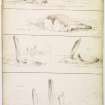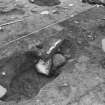Pricing Change
New pricing for orders of material from this site will come into place shortly. Charges for supply of digital images, digitisation on demand, prints and licensing will be altered.
Arran, Machrie Moor 1
Plough Marks, Stone Circle (Neolithic) - (Bronze Age), Timber Circle(S) (Neolithic), Flake(S) (Pitchstone), Unidentified Pottery
Site Name Arran, Machrie Moor 1
Classification Plough Marks, Stone Circle (Neolithic) - (Bronze Age), Timber Circle(S) (Neolithic), Flake(S) (Pitchstone), Unidentified Pottery
Canmore ID 39703
Site Number NR93SW 1.04
NGR NR 91196 32399
Datum OSGB36 - NGR
Permalink http://canmore.org.uk/site/39703
First 100 images shown. See the Collections panel (below) for a link to all digital images.
- Council North Ayrshire
- Parish Kilmory
- Former Region Strathclyde
- Former District Cunninghame
- Former County Buteshire
NR93SW 1.04 9198 32393.
D: at NR 9120 3239. This circle is set out around a precisely drawn ellipse the axes of which are 12.69m and 14.58m long. Eleven stones, six granite boulders and five sandstone slabs, set alternatively, form this circle. There appears to have been a sixth slab, in the area of 12 on plan but its location has not been discovered. The six granite boulders, all roughly the same size, measure about 6ft x 4ft x 2ft. Numbers 1 and 11 on plan are in their original positions, as are the five slabs. The other four granite blocks have fallen.
Bryce excavated the centre of this circle and ran a trench to the NE. Nothing was found.
Information from OS (IF) 28 June 1977.
Sources: A Roy, N McGrail and R Carmichael 1963; E W MacKie 1975; J Bryce 1863
NR 9120 3239 A stone circle generally as described above. The geometric pattern and precise measurements given by Roy et al, however, cannot be confirmed.
Surveyed at 1:10,000.
Visited by OS (BS) 13 September 1977
Excavation (1978 - 1979)
Excavations in 1978-9 revealed that the dimensions of this elliptical circle are somewhat smaller than the 14.6 x 12.7m previously given. In the NE quadrant Bryce's waterlogged trench was located cutting through a large circular feature which may prove to be a post hole. By the NW stone a large pile of stones beneath the peat may have been the result of prehistoric field clearance during the later Bronze Age.
H A W Burl 1977; 1980.
Excavation (April 1985 - June 1985)
Excavations at two of the stone circles on Machrie Moor, both approximately 13m In diameter, continued work begun by Aubrey Burl in 1978 and 1979 (not previously reported in Discovery Excav Scot).
Site I, also dug into by James Bryce 1n 1861, consisted of eleven stones, alternately granite boulders and small sandstone slabs, surviving from a probable original' total of twelve. Of the six granite boulders, only one still stood erect; the others either leaned or had fallen over.
Site I had a complex stratigraphy duplicated in part by Site XI. At Site I after the stone circle had fallen into disuse and before peat covered the area, the ground was used as farm land evidenced by field clearance stone heaped against a fallen granite boulder and very slight remnants of field walls. At some time during the use of the stone circle, cremated bone was inserted at the base of one of the orthostats and the cremated remains apparently of a male aged 25-30 were placed In an off-centre pit, with a bone needle and burnt flint knife and covered by an inverted Cordoned Urn.
An approximate circle of stakeholes was found to surround the stones and may have preceded them but the relationship was tenuous. More definite was the fact that prior to the erection of the stone circle, a timber monument had stood in the same place. Postholes for its uprights were located beneath the stoneholes, where investigated, and one produced a Grooved Ware rim sherd.
Before this two intersecting lines of small stakes, not necessarily contemporary, had spanned the site and may indicate the use of hurdle fences for land division. Both of these stake lines cut a dense series of ardmarks generally aligned NE SW but with occasional more widely spaced ardmarks at right angles to them. Further stake lines were located under this horizon.
In the centre of the site two phases of pits had been dug, some of which were stone filled. They formed an approximate circle of 6m diameter. Investigation of these will continue in 1986.
Site XI (continuing Burl's numbering) largely hidden under the peat until 1978, comprised ten stones, all but one of sandstone, and was complete although one stone had fallen since Burl's excavation.
At Site XI there was no evidence for field clearance after the abandonment of the circle. No sequence of timber phase to stone phase for the monument could be proved, as the ten postholes were spaced between the standing stones with no direct stratigraphical relationship.
During the use of the circle an approximately central pit was dug which contained the cremated remains apparently of a male aged about 30 and a flint core.
Similar pre-circle land division and agricultural phases to those of Site
I were noted, as were various earlier pits which were not fully investigated.
Many finds of pitchstone, flint and pottery came from both sites.
A Haggarty
Sponsor: HB&M
Excavation (April 1986 - June 1986)
The final season of work at stone circles Sites I and XI involved extending the area under excavation to incorporate the two former trenches (Discovery Excav Scot 1985, 41-2).
At Site I postholes representing the complete circuit of the former timber circle directly underlying the stone circle were located, as was a further concentric ring of postholes outwith the stone circle. The central features thought to be two phases of pits resolved themselves into a c 6m diameter ring of large postholes with scoops, presumably to facilitate the erection of the timber uprights. Within Site I a further posthole ring was found which was not concentric with the other three.
Several new lines of stakeholes which possibly indicate the use of hurdle fences were found.
Many more finds of pitchstone and flint were made and some pit features produced large amounts of pottery.
A Haggarty
Sponsor: SDD - HBM
Note (23 July 2018 - 24 July 2018)
The location, classification and period of this site have been reviewed.
HES Survey and Recording 23-24 July 2018.














































































































































































































